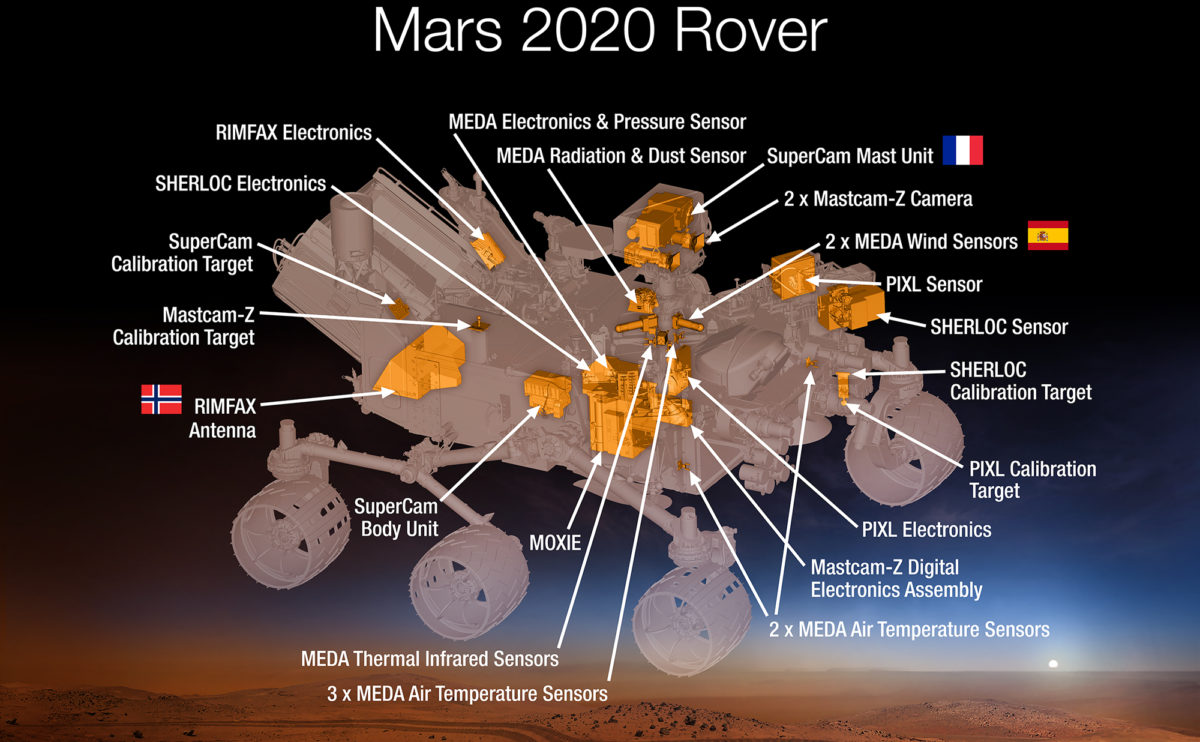Casey Dreier • Jul 31, 2014
[Updated]: NASA Selects 7 Science Instruments for its Next Mars Rover
NASA has selected seven science instruments that will ride along with the next Mars rover mission that is set to launch in 2020.
Compared to Curiosity, the Mars 2020 rover will focus on fine-grained mineralogy to help it detect biosignatures and understand how ancient habitats have changed over time. It will also collect and store samples of the martian surface that could be returned to Earth (though no missions are yet planned to do so).
From the press release, the seven instruments are:

- Mastcam-Z, an advanced camera system with panoramic and stereoscopic imaging capability with the ability to zoom. The instrument also will determine mineralogy of the Martian surface and assist with rover operations. The principal investigator is James Bell, Arizona State University in Phoenix.
- SuperCam, an instrument that can provide imaging, chemical composition analysis, and mineralogy. The instrument will also be able to detect the presence of organic compounds in rocks and regolith from a distance. The principal investigator is Roger Wiens, Los Alamos National Laboratory, Los Alamos, New Mexico. This instrument also has a significant contribution from the Centre National d’Etudes Spatiales,Institut de Recherche en Astrophysique et Plane’tologie (CNES/IRAP) France.
- Planetary Instrument for X-ray Lithochemistry (PIXL), an X-ray fluorescence spectrometer that will also contain an imager with high resolution to determine the fine scale elemental composition of Martian surface materials. PIXL will provide capabilities that permit more detailed detection and analysis of chemical elements than ever before. The principal investigator is Abigail Allwood, NASA's Jet Propulsion Laboratory (JPL) in Pasadena, California.
- Scanning Habitable Environments with Raman & Luminescence for Organics and Chemicals (SHERLOC), a spectrometer that will provide fine-scale imaging and uses an ultraviolet (UV) laser to determine fine-scale mineralogy and detect organic compounds. SHERLOC will be the first UV Raman spectrometer to fly to the surface of Mars and will provide complementary measurements with other instruments in the payload. The principal investigator is Luther Beegle, JPL.
- The Mars Oxygen ISRU Experiment (MOXIE), an exploration technology investigation that will produce oxygen from Martian atmospheric carbon dioxide. The principal investigator is Michael Hecht, Massachusetts Institute of Technology, Cambridge, Massachusetts.
- Mars Environmental Dynamics Analyzer (MEDA), a set of sensors that will provide measurements of temperature, wind speed and direction, pressure, relative humidity and dust size and shape. The principal investigator is Jose Rodriguez-Manfredi, Centro de Astrobiologia, Instituto Nacional de Tecnica Aeroespacial, Spain.
- The Radar Imager for Mars' Subsurface Exploration (RIMFAX), a ground-penetrating radar that will provide centimeter-scale resolution of the geologic structure of the subsurface. The principal investigator is Svein-Erik Hamran, Forsvarets Forskning Institute, Norway.
The Planetary Society is very pleased that our President, Dr. Jim Bell, will lead the camera system on the next rover. The Society is also an official outreach partner on the camera system.
In addition to these seven instruments, NASA plans to include a suite of sensors on the descent stage that will gather data on the atmosphere during the entry, descent, and landing phase of the spacecraft. Curiosity had a similar set of sensors. The rover will also have an advanced sample caching system and robotic arm that it will use to take core samples from various rocks. These will be stored in a cache that can be left on the surface for another mission to come and retrieve to Earth.
Fifty-eight instruments were proposed and went through a lengthy review process by NASA. The selected instruments now have to be built and integrated with the rover over the next five years.
Update: Some tidbits from today's press conference with the science team:
- It seems that Mars 2020 will not be able to take the equivalent of Curiosity's selfies—there are multiple hand lens cameras, but they don't have the proper focal distance to image the full rover.
- The MOXIE instrument has a goal of producing 22g of O2 per hour for 50-sols (martian days).
- SuperCam, the souped up version of ChemCam, will have the same spacial resolution for its zoom camera, but will be in color.
- I couldn't get in a question to confirm this, but it sounds like MEDA will contain a CCD camera bolted onto the surface of the rover.
- Total instrument mass is around 45kg, substantially less than Curiosity's 80kg (though this doesn't include the sample cache or robotic arm).
Support our core enterprises
Your support powers our mission to explore worlds, find life, and defend Earth. You make all the difference when you make a gift. Give today!
Donate

 Explore Worlds
Explore Worlds Find Life
Find Life Defend Earth
Defend Earth

